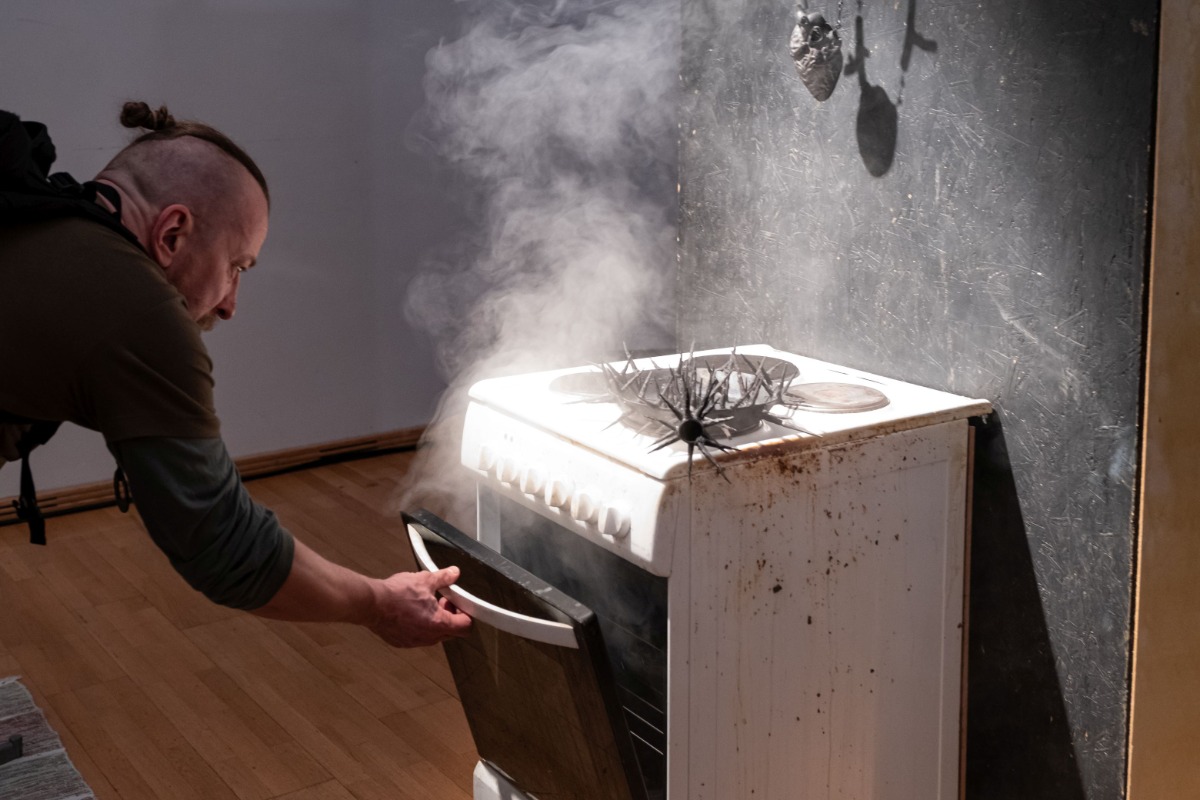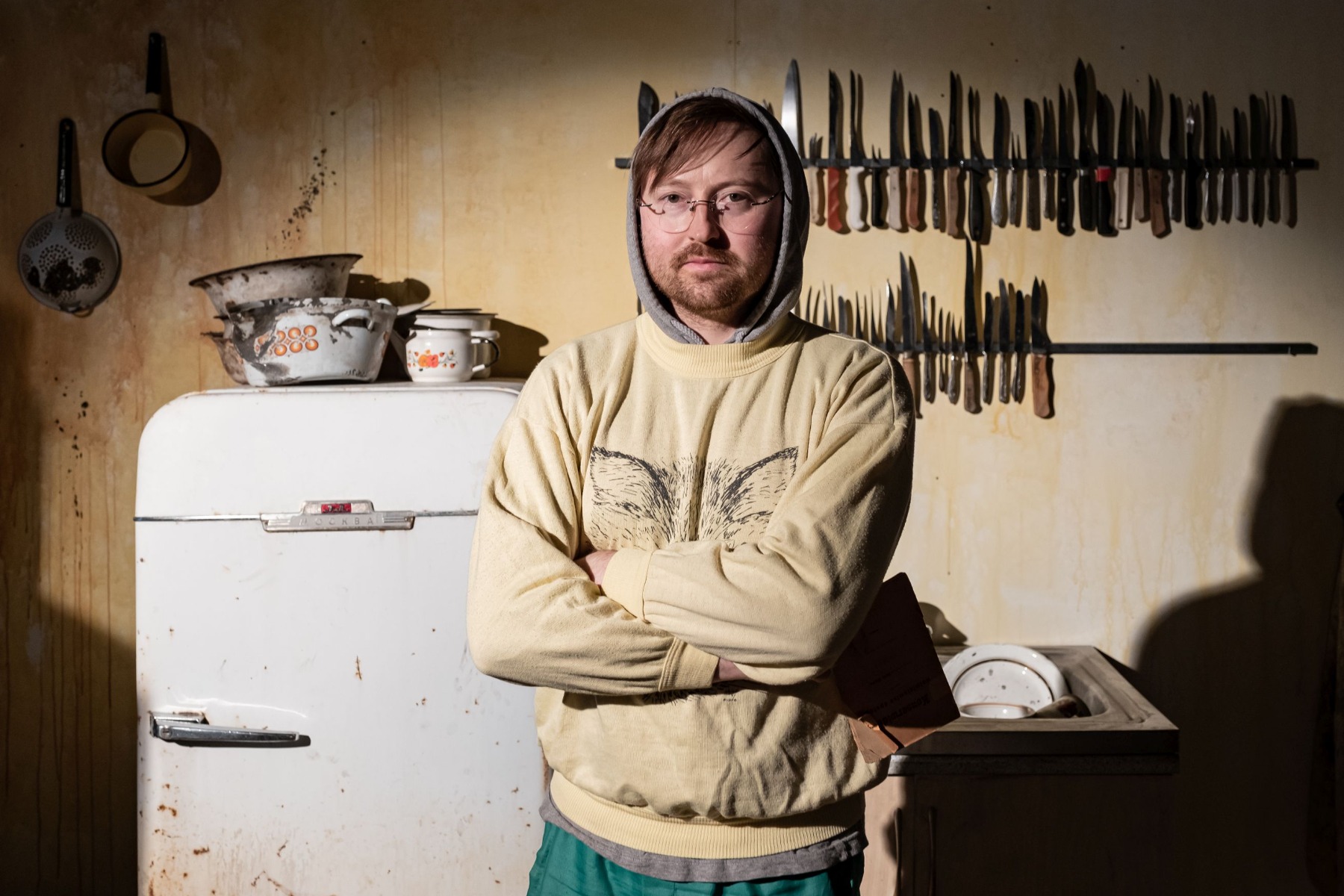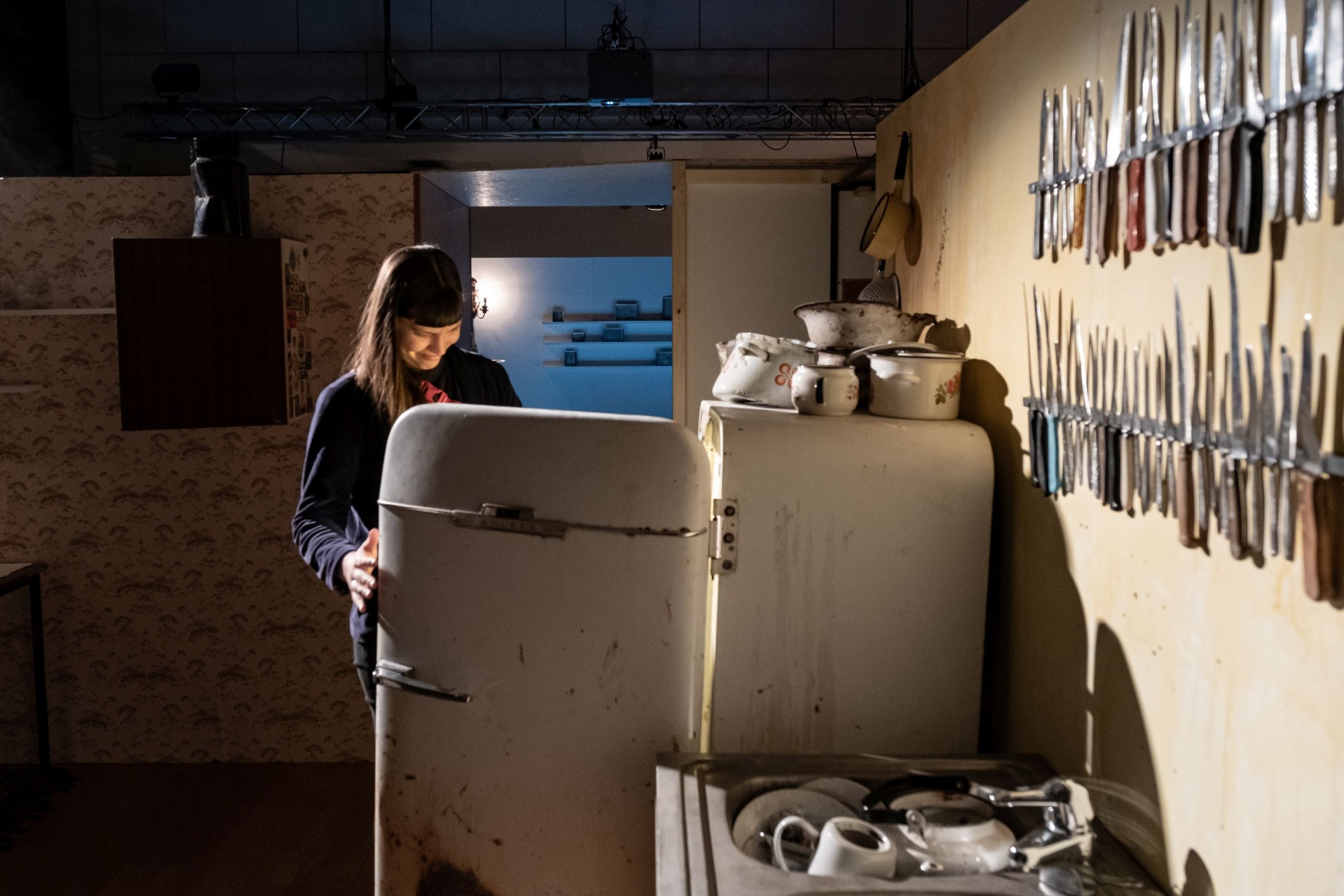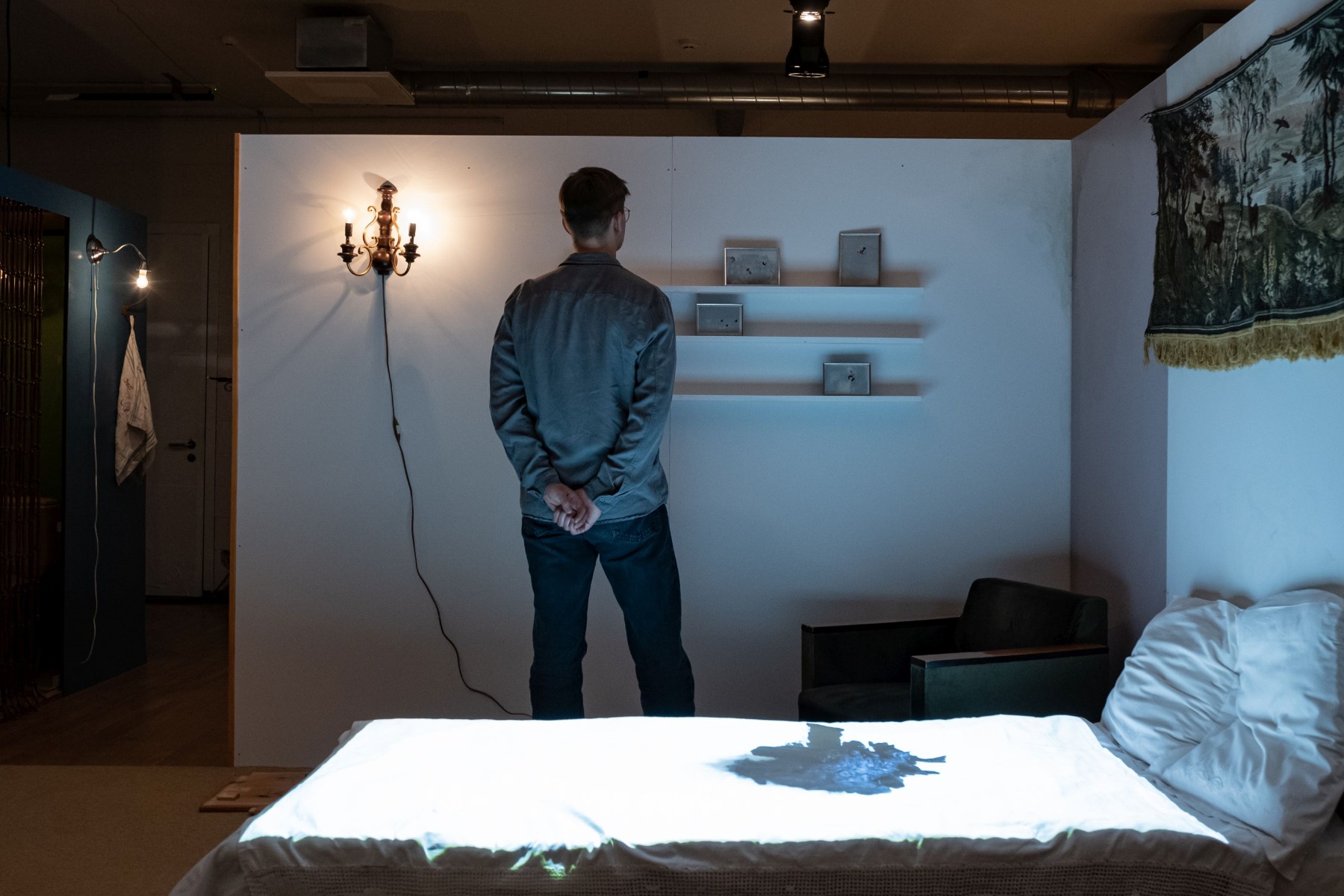
Poliamori in Telliskivi
Review of Urmas Lüüs’ performance-installation Overcrowded Loneliness
Why does darkness scare us if it is just an absence? Love horror vacui.
Me and my objects form one melancholy. Love hyperlink.
Your life and mine are counted by millennia. Love infinite.
Urmas Lüüs, ambassador of the other world disguised as a plumber, sits on a corner of the waiting room without telling visitors that he is, indeed, the Hitchcock behind Overcrowded Loneliness. Unfortunately, we had never been introduced before, thus I walk towards him to do so and he reacts by saying ‘Francesco!’ (as if he were awaiting this fellow vampire).
Urmas Lüüs
During my visit to the installation, an architecture historian tries to explain the installation to her daughter. Nonetheless, Urmas’ assemblage appears to me as pre-verbal, frontational, and beyond linear accumulative meaning, trespassing the limits of its own materiality. More than an atmosphere, he creates networks of felt ideas with visual and physical objects. Each of the agents of the assemblage is as an inductive link, forming a cloud of possibilities and potentialities. Writer Agustín Fernández Mallo has described this form of connecting things as “complex realism”, which in turn creates new “kinships of objects”.[1]
Bodies without passion are also landscape. Love depression.
When a couple breaks up, the streets of our shared city are abandoned, the wind blows in the avenues of our memories, the parks where our picnics took place rest cold, the benches of our quarrels and caresses are left unclean. The same when one becomes a widow. Love urban planning.
Hand in hand towards death. I imagine your ghostly face and mourn you even if you’re still alive. Love à la Heidegger.
“How lonely can we be? And is it possible to be alone these days?” Urmas receives me with these two seemingly contradictory questions.
We have masks for that, I respond.
“As you will see, what I use in the installation are not masks but drag, which allows me to create an imaginary character largely based on different relatives – my grandmother, my aunt… I merely display the footprints of those who came across me physically or mentally”.
Loneliness is an exact fantasy that you can see and touch in this performance-installation. Dull knives and the act of sharpening make you feel the passive aggressiveness accumulated over generations. There are clocks that seem to be running backwards, trying to escape from time. There are mirrors that reveal your shadow or your ghost (depending on your faith in Carl Jung). There is black water from the tap and also the filthy remains of our friendship in the bathtub.

All of these are objects that mean too much to be comprehended, excessive as death is.
It is hard to prove that objects occupy a place and time inside of us, but this does not mean that they do not. Theodor Adorno criticised Walter Benjamin for believing that some objects have the capacity of looking back at us in their “petrified unrest”.[2] But objects have a relational component in their definition; They are angled and selective, entailing a world-making capability, initiating access to a beyond, while simultaneously putting you in place.[3]
You are for me like the lonely eye of the Cyclopes. Love just one.
You bring light to my life. Love blackout.
To know something is to possess it; alas, to love someone is to own her too. Love possession.
In the rather gothic Rebecca (1939), Joan Fontaine plays the role of the second wife of Maxim de Winter. He had had a wife named Rebecca whom he had been deeply in love with, but she had died years before under strange circumstances. Mr. de Winter is still obsessed with her, to the point that the new bride believes that she’s just a replacement for his true love. Another creepy love triangle is told by Hitchcock in Vertigo (1958). This time James Stewart plays an ex-detective with acrophobia, hired by an acquaintance to keep an eye on his wife Madeleine (Kim Novak). As it happens, Scottie becomes obsessed with the woman he is stalking, yet fails to save her from falling to her death. He is inconsolable until he meets Judy, who bears a resemblance to Madeleine. He then tries to recreate his repressed love by dressing Judy in the same clothes as Madeleine.
Urmas Lüüs was trained as a designer, presents himself as an artist, and works like an archaeologist.
“There is a human space in each object, which itself creates people back,” insists Urmas. He wanted to create a “one-second performance”, collapsing future and past through an assemblage of things. Following that purpose, books, jewelry and unwashed dishes create a sense of an absent presence, and anti-designed things deconstruct the aesthetics of modernity (because they are not useful but obtrusive). All this is accompanied by a series of sound, light and video effects as well as different atmospheric foreign bodies.

The display is divided into rooms and draws on his previous exhibition On the Porosity of Certain Boundaries (Hobusepea, 2021). “After my grandmother left, I started to empty the apartment for repairs. 83 years of life had accumulated in front of me”.
Urmas paraphrases the dictum about friendship to argue “tell me what your objects at home are, and I will say who you are. A person's identity is deeply shaped by the objects around them”.
Jean Paul Sartre (1967) argued that it would be possible to answer the question of “Who are we?” by paying attention to the things we have. Our activity of accumulating things defines ourselves – the clothing that we collect in our wardrobe, the cutlery in our kitchen, the way we furnish our house, the drawing by our son on our desk, the amulet of luck that we secretly keep in the pocket of our raincoat, and so on. The most meaningful things in our homes might be those items that were not originally perceived as collectible units (just pay attention to your garbage and dirty laundry).

Overcrowded loneliness is a dystopian Wonderland with no Alice. One does not know which door to knock on, where to look, what to touch, what to open and what to close – to the point that most visitors miss an extra room – while Urmas rejoices this very fact.
The guinea pig is us.
But can we compare our relationship to people and to objects? After investigating the interiors of 30 households in London, anthropologist Daniel Miller questions the assumption of objects merely being that which is passively worked upon. In his view, material culture may be regarded as possessing agency too, for instance, contributing to domestic distractions, comforts, order, expressing relationships, and in some cases, generating self-deception, oppression and alienation.

One of the examples that Miller provides is George’s flat: disorienting because of its emptiness, a chilling absence that is experienced by the visitor as violent, tense, impolite. “This is a man for whom putting on the second sock would be an entirely separate activity from putting on the first sock”.[4] The material void of his flat comes to represent all that has not happened to George, his enforced retirement at the age of fifty-five, his previous work as a clerk in a large company, his difficulties in taking individual decisions and responsibility, his loneliness, and perhaps also his depression: there were no decorations because there was just no point.
What beautiful garbage. Our love grows between our inner and outer dirt. Love stain.
All the information in the world is contained between you and me. Love big data.
I enter into myself when I am with you. Love swimming pool.
We are afraid of feelings because they show us as vulnerable; not heroic but fragile and corporeal: bodies in need of caresses, kisses and compliments. Because falling in love is letting another one invade your body and your mind, connecting worlds in a radical intercourse of different lonelinesses.
Relying on Freud’s work, sociologist Klaus Theweleit argues that we choose objects in the same way we fall in love – based on unconscious drives, without rational understanding, even blind to our own motives and desires.[5] Also in the psychoanalytic tradition, Jean Baudrillard argued that the possession of objects is a tempered mode of sexual perversion.[6]
Nothing, and so it will be after our intercourse. Love hole.
Inside you, what a warm, submerged zenith. Love Icarus.
Enamorá' de tu pistola, roja amapola. Amor Rosalía.
Urmas concludes: “Loneliness is one of the most brutal pandemics of our time. It breaks you, paralyses you, throws you down. It can enter through the window, through the TV or through the iPhone. We have never been so closely surrounded by other people, and yet humanity has never suffered from such a widespread sense of loneliness”.
That affects the way we love too, which we increasingly practice in a swashbuckling, roly-poly manner. Love crisis of crisis.
***
Overcrowded Loneliness is open at the Independent Dance Hall (Telliskivi / Estonia) between 12-30 April.
Francisco Martínez is an anthropologist interested in material culture, social design, and ethnographic experiments
***